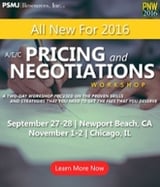 With the preliminary contract in hand, it’s time to get to the real task of creating business relationships—negotiating and closing the deal! A project manager's job is not only to negotiate equitable contracts but also to gain valuable insight about the client. Then, armed with the contract and this insight—you will lead your team to success.
With the preliminary contract in hand, it’s time to get to the real task of creating business relationships—negotiating and closing the deal! A project manager's job is not only to negotiate equitable contracts but also to gain valuable insight about the client. Then, armed with the contract and this insight—you will lead your team to success.
The classic “deal” negotiation is selling a used car. The seller wants to get the highest possible price; the buyer wants the lowest possible price. Both parties want to conclude the deal and never discuss the matter after the deal is made. (Post-deal discussions mean that there is a possible dispute that neither party desires.) In its essence, such a deal is a mere transaction.All negotiations fall into two categories:
1. Transactional, or “deal,” negotiations
2. “Relationship” negotiations
“Relationship” negotiations are fundamentally different. Both parties negotiate a business arrangement that will enable them to enter into a mutually beneficial relationship. Many larger clients attempt to narrow down their suppliers to a small number of successful firms. Therefore, approach the conclusion of the first contract negotiation with the idea that it will be the start of a new relationship, or a continuation of an existing one, rather than just winning the current “deal.”
Win-Win Negotiations
The ideal outcome is when both you and the client win; that is, each receives a benefit as a result of the project. This generally occurs when you are able to negotiate a fee that provides your firm with a reasonable profit, while agreeing to a price that is within the client’s budget.
To achieve a win-win outcome, the design firm must view the negotiation from the client’s perspective, as well as its own, and not take undue advantage of weaknesses in the client’s position. Likewise, do not allow the client to take advantage of weaknesses in your position. Both sides leave the negotiating table feeling good about the outcome and are able to work together effectively during the project.
You want to negotiate “hard” but with integrity. Unfortunately, there are cases in which the objectives of the two sides are so far apart that a win-win negotiation is not possible. In these cases, the objective should be to achieve a lose-lose negotiation, in which neither party is happy with the outcome, but both sides feel that the burden is being shared fairly.
The worst outcomes of a negotiation are win-lose and lose-win. If a firm negotiates a contract in which it obtains an apparent windfall profit at the expense of the client’s basic objectives (win-lose), ill will is created. The client will find some way to “get even” if the degree of service provided seems unfair. Future work with the client will no doubt suffer. In the other situation, lose-win, your firm will believe that the client has taken advantage of you. You will be prone to “cutting corners” in order to minimize your losses. In the end, neither you nor your client is happy.
You should not see contract negotiation as an adversarial process. Your thorough and professional understanding of the interplay among the contract, the proposed project, and your firm’s ability to deliver its scope of services gives you the flexibility to initiate the give and take necessary for creative resolution of differences. It is essential that you know--and know clearly--your “walk away” position. This takes
understanding and courage.
You always need to be able to decline to continue the negotiation, no matter who the client is, if you cannot develop acceptable terms. Many firms can recount stories of having given up way too much at the outset in order to win the contract and never really got the project on firm financial footing after that. Remember also that you can give up more than financial profitability: you can over-promise quality or a too-optimistic time schedule, either of which are impossible to meet and that money cannot reasonably “fix.”
Learning to diplomatically decline an engagement at the negotiation level is a professional skill that will serve you well over your career. In any given instance, it may not even lose a contract. The potential client may be sufficiently impressed with your professionalism to reconsider its bargaining position and resume negotiations.
During the actual negotiations with the client, the project manager should not let anxiety over winning or losing the job cause gross underestimates of staff and time requirements. This will only create a formidable obstacle to successful and profitable completion of the work.
 Are you interested in learning more about best practices in pricing and negotiations? Ever wonder if there really is a way to get the upper hand in negotiations? A way to get the fees (and respect) that you deserve…without losing the client? There is. PSMJ's A/E/C Pricing and Negotiations Workshop is packed with 40+ years of proven strategies and tactics that the most successful architecture and engineering professionals are using right now to get results.
Are you interested in learning more about best practices in pricing and negotiations? Ever wonder if there really is a way to get the upper hand in negotiations? A way to get the fees (and respect) that you deserve…without losing the client? There is. PSMJ's A/E/C Pricing and Negotiations Workshop is packed with 40+ years of proven strategies and tactics that the most successful architecture and engineering professionals are using right now to get results.

You also might be interested in these related posts:
How to Increase Fees when Clients Use Price for Selection
Break Your Fees Down - Keep Your Prices Up
What’s the Secret to Winning Every Negotiation?


